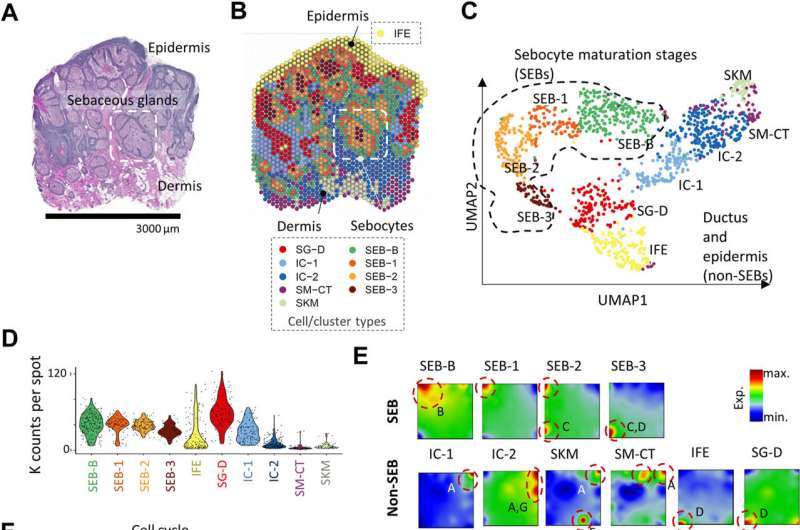This article has been reviewed according to Science X's editorial process and policies. Editors have highlighted the following attributes while ensuring the content's credibility:
fact-checked
peer-reviewed publication
trusted source
proofread
Keeping skin healthy: New study provides molecular portrait of sebum production

In a collaborative project between the Faculty of Veterinary Medicine and the Interdisciplinary Center for Bioinformatics (IZBI) at Leipzig University, changes in gene expression in sebaceous glands have been spatially mapped for the first time. The study documents at high resolution changes in gene expression in the course of sebum synthesis and identifies new candidates for the modulation of sebum production.
The researchers have published their findings in the Journal of Biological Chemistry.
Sebaceous glands are essential for maintaining the structure and function of the skin. In a process known as holocrine secretion, cells in the periphery of the gland accumulate large amounts of lipid molecules, are transported to the center of the gland and eventually rupture, releasing an oily secretion (sebum) that protects the skin's surface and keeps it supple.
In humans and most mammals, sebum has other important but largely unexplored functions, such as protecting against UVB-induced apoptosis (cell death) or contributing to the skin's innate immune response. Sebum production can also affect energy metabolism throughout the body.
Deregulation of the sebaceous gland is a key factor in the development of acne and also plays a role in other skin conditions such as eczema, a chronic and itchy inflammation of the upper layers of the skin, and psoriasis.
Recent studies also indicate that sebum production can have important immunomodulatory effects and influence the energy metabolism of the entire organism. Modulation of sebum secretion may therefore be an attractive therapeutic target not only for skin diseases, but also for infectious and metabolic diseases.
"Quite apart from their importance in skin health, sebaceous glands are an attractive and accessible model for understanding fundamental biological processes such as lipid synthesis, stem cell function or tumor development," says Professor Marlon R. Schneider. He heads the Institute of Veterinary Physiology at Leipzig University and initiated and supervised the study.
However, there has been no detailed study of the changes in gene expression in sebocytes (sebaceous gland cells) that lead to sebum production. In this recently published study, the two research groups integrated new methods, such as spatial analysis of gene expression, pseudotime analysis and functional enrichment, to map the progressive development of sebaceous gland cells up to cell lysis.
Based on four stages of cell differentiation generated by unsupervised clustering, the data show a consecutive modulation of cellular functions that can be associated with specific gene sets, from cell proliferation and oxidative phosphorylation to lipid synthesis and cell death.
The results were validated by comparison with previously published sebaceous gland transcriptome data and further corroborated by analysis of the protein expression patterns of a selected subset of the transcripts in the publicly available Human Protein Atlas. The study is also supplemented by a freely available and searchable online tool.
PD Dr. Hans Binder, former director of the Interdisciplinary Center for Bioinformatics (IZBI) at Leipzig University, emphasizes the importance of an online bioinformatics tool developed in parallel. "The method is highly data-driven. Researchers around the world can use the tool to search and independently analyze our data."
Combining different methods provides a comprehensive and new understanding of the gene expression dynamics underlying sebaceous gland differentiation. The data suggest a continuous development of sebaceous cells through a consecutive modulation of cellular functions that can be linked to specific gene sets. The study identifies new players in sebum production, providing new ways to modulate sebum production and pointing to future experimental approaches of medical relevance.
Next target: Skin conditions and tears
In the next step, gene expression changes in the sebaceous gland in connection with certain skin conditions will be characterized in more detail. Especially for eczema and psoriasis, but also for sebaceous gland tumors. These investigations will utilize the next stage of development of the spatial transcriptome analysis method, which enables results to be obtained at the single cell level.
Dr. Maria Schmidt, the first author of the study, explains, "In 2020, the prestigious journal Nature named spatially resolved gene expression its Method of the Year. As a combination of molecular biology and microscopy, it is highly data-driven and, in combination with sophisticated bioinformatics, opens up new insights into the organization of life processes in space and time at cellular resolution."
In addition to the sebaceous glands of the skin, there are specialized sebaceous glands that perform very specific functions in the body. Meibomian glands along the rim of the eyelids, for example, produce an oily substance that forms the lipid layer (fatty phase) of the tear film. This prevents tears from evaporating. When this lipid layer is disrupted, it causes inflammation and dry eyes. A similar mapping of gene expression changes in the meibomian gland is nearing completion.
More information: Maria Schmidt et al, A spatial portrait of the human sebaceous gland transcriptional program, Journal of Biological Chemistry (2024). DOI: 10.1016/j.jbc.2024.107442
Journal information: Nature , Journal of Biological Chemistry
Provided by Leipzig University



















